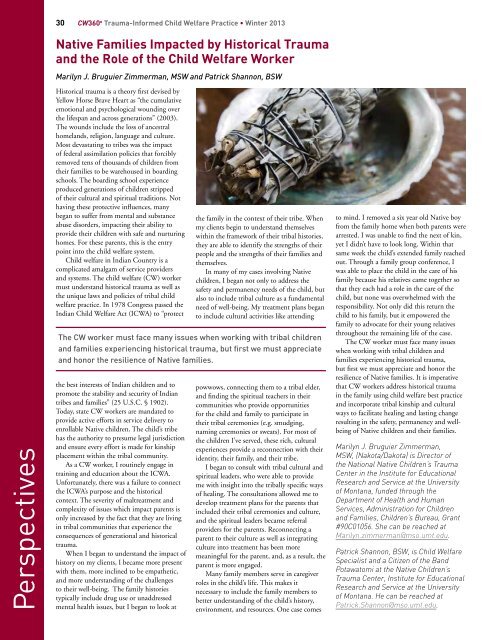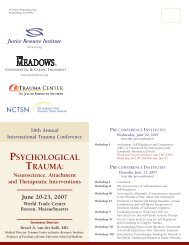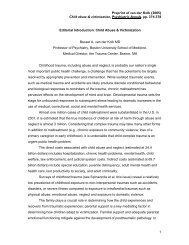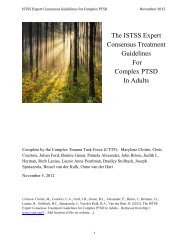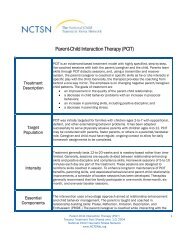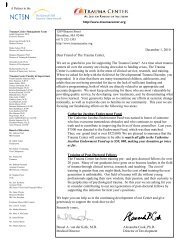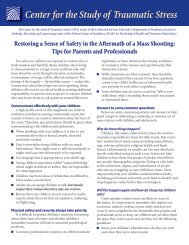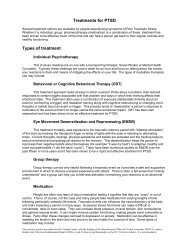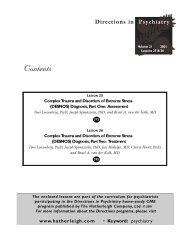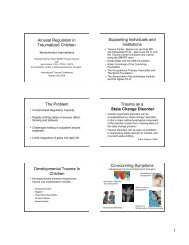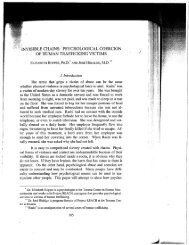in Child Welfare - The Trauma Center
in Child Welfare - The Trauma Center
in Child Welfare - The Trauma Center
Create successful ePaper yourself
Turn your PDF publications into a flip-book with our unique Google optimized e-Paper software.
30 CW360 o <strong>Trauma</strong>-Informed <strong>Child</strong> <strong>Welfare</strong> Practice • W<strong>in</strong>ter 2013PerspectivesNative Families Impacted by Historical <strong>Trauma</strong>and the Role of the <strong>Child</strong> <strong>Welfare</strong> WorkerMarilyn J. Bruguier Zimmerman, MSW and Patrick Shannon, BSWHistorical trauma is a theory first devised byYellow Horse Brave Heart as “the cumulativeemotional and psychological wound<strong>in</strong>g overthe lifespan and across generations” (2003).<strong>The</strong> wounds <strong>in</strong>clude the loss of ancestralhomelands, religion, language and culture.Most devastat<strong>in</strong>g to tribes was the impactof federal assimilation policies that forciblyremoved tens of thousands of children fromtheir families to be warehoused <strong>in</strong> board<strong>in</strong>gschools. <strong>The</strong> board<strong>in</strong>g school experienceproduced generations of children strippedof their cultural and spiritual traditions. Nothav<strong>in</strong>g these protective <strong>in</strong>fluences, manybegan to suffer from mental and substanceabuse disorders, impact<strong>in</strong>g their ability toprovide their children with safe and nurtur<strong>in</strong>ghomes. For these parents, this is the entrypo<strong>in</strong>t <strong>in</strong>to the child welfare system.<strong>Child</strong> welfare <strong>in</strong> Indian Country is acomplicated amalgam of service providersand systems. <strong>The</strong> child welfare (CW) workermust understand historical trauma as well asthe unique laws and policies of tribal childwelfare practice. In 1978 Congress passed theIndian <strong>Child</strong> <strong>Welfare</strong> Act (ICWA) to “protectthe best <strong>in</strong>terests of Indian children and topromote the stability and security of Indiantribes and families” (25 U.S.C. § 1902).Today, state CW workers are mandated toprovide active efforts <strong>in</strong> service delivery toenrollable Native children. <strong>The</strong> child’s tribehas the authority to presume legal jurisdictionand ensure every effort is made for k<strong>in</strong>shipplacement with<strong>in</strong> the tribal community.As a CW worker, I rout<strong>in</strong>ely engage <strong>in</strong>tra<strong>in</strong><strong>in</strong>g and education about the ICWA.Unfortunately, there was a failure to connectthe ICWA’s purpose and the historicalcontext. <strong>The</strong> severity of maltreatment andcomplexity of issues which impact parents isonly <strong>in</strong>creased by the fact that they are liv<strong>in</strong>g<strong>in</strong> tribal communities that experience theconsequences of generational and historicaltrauma.When I began to understand the impact ofhistory on my clients, I became more presentwith them, more <strong>in</strong>cl<strong>in</strong>ed to be empathetic,and more understand<strong>in</strong>g of the challengesto their well-be<strong>in</strong>g. <strong>The</strong> family historiestypically <strong>in</strong>clude drug use or unaddressedmental health issues, but I began to look atthe family <strong>in</strong> the context of their tribe. Whenmy clients beg<strong>in</strong> to understand themselveswith<strong>in</strong> the framework of their tribal histories,they are able to identify the strengths of theirpeople and the strengths of their families andthemselves.In many of my cases <strong>in</strong>volv<strong>in</strong>g Nativechildren, I began not only to address thesafety and permanency needs of the child, butalso to <strong>in</strong>clude tribal culture as a fundamentalneed of well-be<strong>in</strong>g. My treatment plans beganto <strong>in</strong>clude cultural activities like attend<strong>in</strong>g<strong>The</strong> CW worker must face many issues when work<strong>in</strong>g with tribal childrenand families experienc<strong>in</strong>g historical trauma, but first we must appreciateand honor the resilience of Native families.powwows, connect<strong>in</strong>g them to a tribal elder,and f<strong>in</strong>d<strong>in</strong>g the spiritual teachers <strong>in</strong> theircommunities who provide opportunitiesfor the child and family to participate <strong>in</strong>their tribal ceremonies (e.g. smudg<strong>in</strong>g,nam<strong>in</strong>g ceremonies or sweats). For most ofthe children I’ve served, these rich, culturalexperiences provide a reconnection with theiridentity, their family, and their tribe.I began to consult with tribal cultural andspiritual leaders, who were able to provideme with <strong>in</strong>sight <strong>in</strong>to the tribally specific waysof heal<strong>in</strong>g. <strong>The</strong> consultations allowed me todevelop treatment plans for the parents that<strong>in</strong>cluded their tribal ceremonies and culture,and the spiritual leaders became referralproviders for the parents. Reconnect<strong>in</strong>g aparent to their culture as well as <strong>in</strong>tegrat<strong>in</strong>gculture <strong>in</strong>to treatment has been moremean<strong>in</strong>gful for the parent, and, as a result, theparent is more engaged.Many family members serve <strong>in</strong> caregiverroles <strong>in</strong> the child’s life. This makes itnecessary to <strong>in</strong>clude the family members tobetter understand<strong>in</strong>g of the child’s history,environment, and resources. One case comesto m<strong>in</strong>d. I removed a six year old Native boyfrom the family home when both parents werearrested. I was unable to f<strong>in</strong>d the next of k<strong>in</strong>,yet I didn’t have to look long. With<strong>in</strong> thatsame week the child’s extended family reachedout. Through a family group conference, Iwas able to place the child <strong>in</strong> the care of hisfamily because his relatives came together sothat they each had a role <strong>in</strong> the care of thechild, but none was overwhelmed with theresponsibility. Not only did this return thechild to his family, but it empowered thefamily to advocate for their young relativesthroughout the rema<strong>in</strong><strong>in</strong>g life of the case.<strong>The</strong> CW worker must face many issueswhen work<strong>in</strong>g with tribal children andfamilies experienc<strong>in</strong>g historical trauma,but first we must appreciate and honor theresilience of Native families. It is imperativethat CW workers address historical trauma<strong>in</strong> the family us<strong>in</strong>g child welfare best practiceand <strong>in</strong>corporate tribal k<strong>in</strong>ship and culturalways to facilitate heal<strong>in</strong>g and last<strong>in</strong>g changeresult<strong>in</strong>g <strong>in</strong> the safety, permanency and wellbe<strong>in</strong>gof Native children and their families.Marilyn J. Bruguier Zimmerman,MSW, (Nakota/Dakota) is Director ofthe National Native <strong>Child</strong>ren’s <strong>Trauma</strong><strong>Center</strong> <strong>in</strong> the Institute for EducationalResearch and Service at the Universityof Montana, funded through theDepartment of Health and HumanServices, Adm<strong>in</strong>istration for <strong>Child</strong>renand Families, <strong>Child</strong>ren’s Bureau, Grant#90C01056. She can be reached atMarilyn.zimmerman@mso.umt.edu.Patrick Shannon, BSW, is <strong>Child</strong> <strong>Welfare</strong>Specialist and a Citizen of the BandPotawatomi at the Native <strong>Child</strong>ren’s<strong>Trauma</strong> <strong>Center</strong>, Institute for EducationalResearch and Service at the Universityof Montana. He can be reached atPatrick.Shannon@mso.umt.edu.


